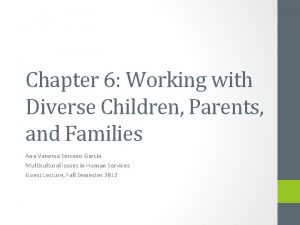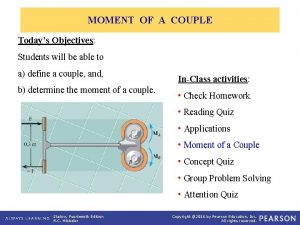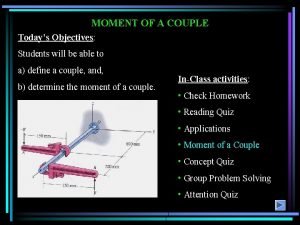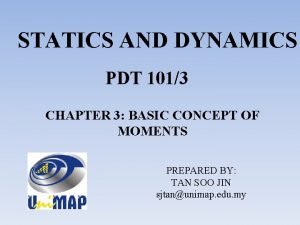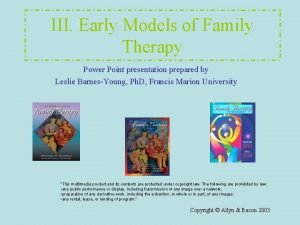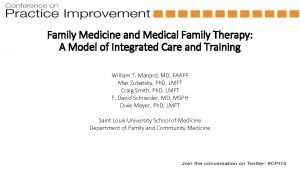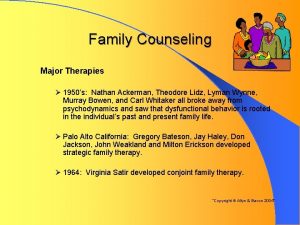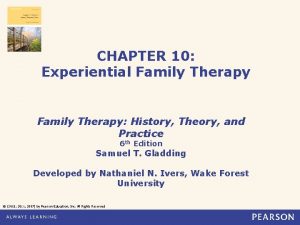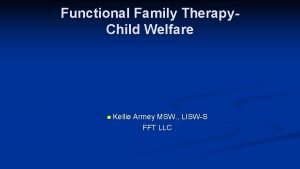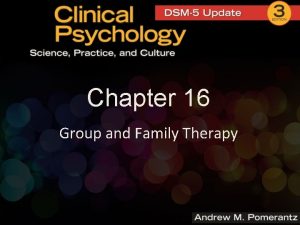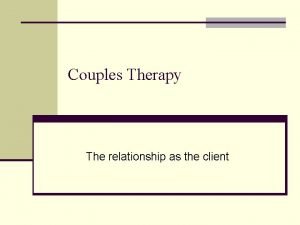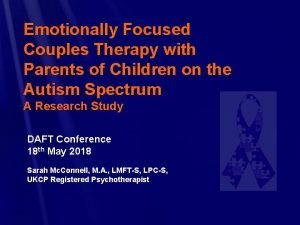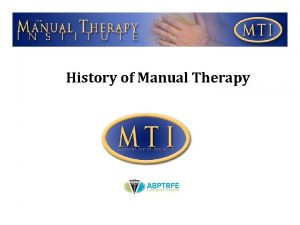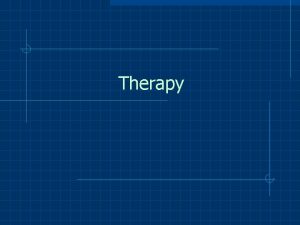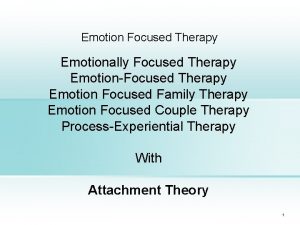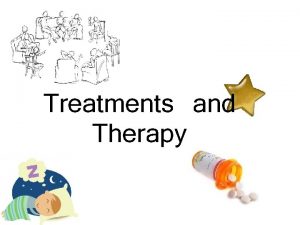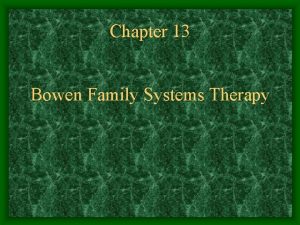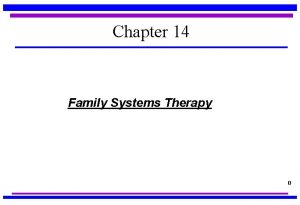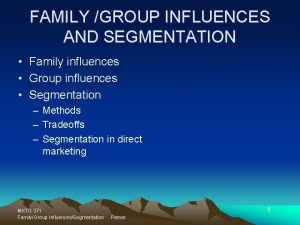Chapter 15 Family Couples and Group Therapy Copyright





























- Slides: 29

Chapter 15 Family, Couples, and Group Therapy Copyright © 2012 Wolters Kluwer Health | Lippincott Williams & Wilkins

The phenomena of emotional bonding, role enactment, communication, sexuality, and the broader system that provides the context for a relationship become the focus of couple therapy when conflict occurs. Chisholm, 1996 Copyright © 2012 Wolters Kluwer Health | Lippincott Williams & Wilkins

Interest in the family of the psychiatric patient has blended over the years to interest in the family as the psychiatric patient. This conceptual focus on the family as a whole instead of one individual member is the key element of the family therapy approach. Jones, 1980 Copyright © 2012 Wolters Kluwer Health | Lippincott Williams & Wilkins

Groups are a crucial part of life experience for people. . They constitute a potent force for the prevention and remediation of personal and social problems. Brill, Levine, and Brill, 2001 Copyright © 2012 Wolters Kluwer Health | Lippincott Williams & Wilkins

Learning Objectives After studying this chapter, you should be able to • Describe at least three alternatives to the traditional nuclear family • Articulate the developmental stages of the family according to Duvall’s theory of the family life cycle • Compare and contrast characteristics of functional and dysfunctional families • Explain the development of couples, family, and group therapy • Understand the purpose of couples, family, and group therapy • Analyze four different modes of family therapy, stating the role of therapist in each mode • Distinguish the goals of couples and family therapy Copyright © 2012 Wolters Kluwer Health | Lippincott Williams & Wilkins

Learning Objectives (cont. ) • Develop a couple or family assessment guide • Formulate a list of the common nursing diagnoses applicable to families participating in family therapy • Create a genogram and explain its usefulness in family therapy • Recognize the advantages of group therapy • Identify at least six factors considered to be essential components of group therapy • Construct the stages of group development in group therapy • Compare and contrast the nurse–therapist’s role in couples, family, and group therapy Copyright © 2012 Wolters Kluwer Health | Lippincott Williams & Wilkins

Overview of Families • Family life cycle • Healthy functioning families • Dysfunctional families • Culturally diverse families Copyright © 2012 Wolters Kluwer Health | Lippincott Williams & Wilkins

History of Family and Couples Therapy • Treating individuals with problems • Including the family or couple • Viewing the family as a system of relationships Copyright © 2012 Wolters Kluwer Health | Lippincott Williams & Wilkins

Family Therapy • Approaches to family therapy • Goals of family therapy • Stages of family therapy Copyright © 2012 Wolters Kluwer Health | Lippincott Williams & Wilkins

Approaches to Family Therapy • Integrative approach • Psychoanalytic approach • Bowen approach • Structural approach • Interactional or strategic approach • Social network or systemic approach • Behaviorist approach Copyright © 2012 Wolters Kluwer Health | Lippincott Williams & Wilkins

Establishing Goals of Family Therapy • Facilitate positive changes in the family • Fostering open communication of thoughts and feelings • Promoting optimal functioning in interdependent roles Copyright © 2012 Wolters Kluwer Health | Lippincott Williams & Wilkins

Stages of Family Therapy • The initial interview • The intervention or working phase • The termination phase Copyright © 2012 Wolters Kluwer Health | Lippincott Williams & Wilkins

The Nurse–Therapist’s Role in Family Therapy The clinical nurse specialist or nurse practitioner can function in many highly skilled roles, one of which is serving as a family therapist. • Nurses in the role of family therapists: – Conduct family assessments • Family history genogram – Participate in family teaching and education – Provide family therapy Copyright © 2012 Wolters Kluwer Health | Lippincott Williams & Wilkins

Sample Genogram Copyright © 2012 Wolters Kluwer Health | Lippincott Williams & Wilkins

Couples Therapy • Types of couples therapy • Couple assessment • Goals of couples therapy Copyright © 2012 Wolters Kluwer Health | Lippincott Williams & Wilkins

Types of Couples Therapy • Marital-relations therapy • Contextual therapy • Object-relations therapy • Brief couples therapy Copyright © 2012 Wolters Kluwer Health | Lippincott Williams & Wilkins

Couple Assessment • It requires the collection of more comprehensive data about physical or mental illness in either or both partners, difficulties in interpersonal and/or sexual relationship of the couple, and identification of any developmental issues either partner may be experiencing. Copyright © 2012 Wolters Kluwer Health | Lippincott Williams & Wilkins

Goals of Couples Therapy • Resolve problems and conflicts that couples are unable to handle themselves. • Establishment of trust and loyalty • Enhancement of sexual intimacy • Improvement in listening and expressive skills • Establishment of empathy for each individual Copyright © 2012 Wolters Kluwer Health | Lippincott Williams & Wilkins

Group Therapy • Characteristics of group therapy • Types of therapy groups • Establishment of a group • Stages of group development • Group leadership styles • The nurse–therapist’s role Copyright © 2012 Wolters Kluwer Health | Lippincott Williams & Wilkins

Advantages of Group Therapy • Decreased isolation and dependence • Opportunities for helping others • Interpersonal learning and development of coping skills • Decreased transference to therapist while developing the ability to listen to other group members Copyright © 2012 Wolters Kluwer Health | Lippincott Williams & Wilkins

11 Essential Elements of Group Therapy • Instillation of hope • Universality • Imparting of information • Altruism • Corrective recapitulation of the primary family group • Development of socializing techniques • Imitative behavior • Interpersonal learning • Group cohesiveness • Catharsis • Existential factors Copyright © 2012 Wolters Kluwer Health | Lippincott Williams & Wilkins

Types of Therapy Groups • Open groups • Closed groups Copyright © 2012 Wolters Kluwer Health | Lippincott Williams & Wilkins

Five Models of Group Therapy • Support groups • Reeducation and remotivation groups • Problem-solving therapy groups • Insight without reconstruction groups • Personality reconstruction groups Copyright © 2012 Wolters Kluwer Health | Lippincott Williams & Wilkins

Establishment of a Group • Size • Diagnosis of participants • Age • Gender • Intellectual level • Verbal or communication skills • Motivation • Social skills • Individual client needs Copyright © 2012 Wolters Kluwer Health | Lippincott Williams & Wilkins

Stages of Group Development • Orientation phase • Working phase • Termination phase Copyright © 2012 Wolters Kluwer Health | Lippincott Williams & Wilkins

Group Leadership Styles • Autocratic group leaders • Democratic group leaders • Laissez-faire group leaders Copyright © 2012 Wolters Kluwer Health | Lippincott Williams & Wilkins

Role of the Nurse–Therapist in Group Therapy • Guide individuals through a problemsolving process • Task role functions • Maintenance role functions In these roles, the primary purpose is to guide individuals through a problem -solving process by anticipating and responding to the needs and concerns of group members. Copyright © 2012 Wolters Kluwer Health | Lippincott Williams & Wilkins

Key Terms • Autocratic group leader • Families • Brief couples therapy • Family therapy • Closed groups • Group therapy • Contextual therapy • Healthy functioning family • Couples therapy • Democratic group leader • Laissez-faire group leader • Dysfunctional families • Marital-relations therapy • Object-relations therapy • Open groups Copyright © 2012 Wolters Kluwer Health | Lippincott Williams & Wilkins

Reflection Reflect on the chapter’s opening quote: “Interest in the family of the psychiatric patient has blended over the years to interest in the family as the psychiatric patient. This conceptual focus on the family as a whole instead of one individual member is the key element of the family therapy approach. ” Jones, 1980 • Do you agree with the current conceptual focus of family therapy? • If you do not agree with the conceptual focus, what changes would you make in your approach as a family therapist? Copyright © 2012 Wolters Kluwer Health | Lippincott Williams & Wilkins ?
 Stoughton couples therapy
Stoughton couples therapy Anonymonous
Anonymonous Couples in the great gatsby
Couples in the great gatsby Bicultural couples tend to demonstrate extremes in
Bicultural couples tend to demonstrate extremes in What news does puck bring oberon
What news does puck bring oberon Couple moments statics
Couple moments statics What is incremental process model
What is incremental process model A pediatrician wishes to recruit 5 couples
A pediatrician wishes to recruit 5 couples Two couples act on the beam
Two couples act on the beam A couple is applied to the beam as shown. its moment equals
A couple is applied to the beam as shown. its moment equals Facade pattern couples a subsystem from its clients
Facade pattern couples a subsystem from its clients Academic couples
Academic couples 400sin30
400sin30 Psychoanalytic therapy is to as humanistic therapy is to
Psychoanalytic therapy is to as humanistic therapy is to Bioness bits cost
Bioness bits cost Humanistic therapy aims to
Humanistic therapy aims to Usu grad school
Usu grad school Jay haley strategic family therapy
Jay haley strategic family therapy Third order cybernetics
Third order cybernetics Models of family therapy ppt
Models of family therapy ppt Medical family therapy
Medical family therapy Nathan ackerman family therapy
Nathan ackerman family therapy Experiential family therapy satir
Experiential family therapy satir Pretend techniques in strategic family therapy
Pretend techniques in strategic family therapy Experiential family therapy
Experiential family therapy Family therapy part 1
Family therapy part 1 Family attachment narrative therapy
Family attachment narrative therapy Functional family therapy nyc
Functional family therapy nyc Family therapy daft
Family therapy daft Family therapy daft
Family therapy daft



